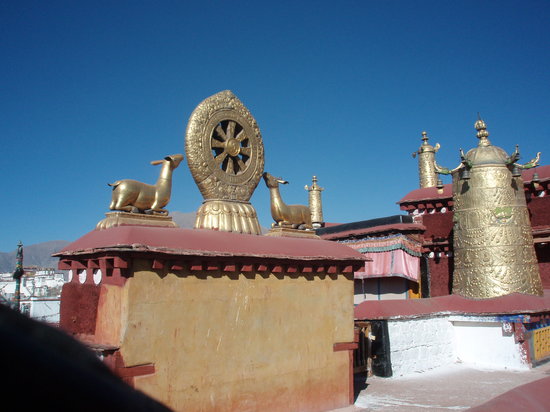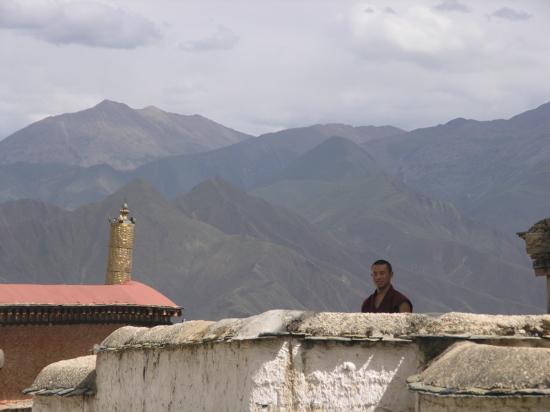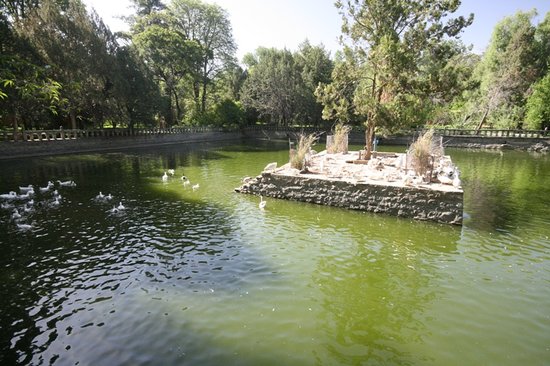Top 10 Things to do in Lhasa, China
Deep in the spectacular Himalayan Mountains, Lhasa is a jewel of a destination. Potala Palace, the former residence of the Dalai Lama, is a major attraction, but you’ll also find numerous important temples and even the world’s highest brewery.
Restaurants in Lhasa
1. Jokhang Temple
Overall Ratings
4.5 based on 1 reviews
Included on UNESCO's World Heritage list in 2000 as part of the Potala Palace, the Jokhang Temple is in the heart of Lhasa downtown. With an area of 25,100 square meters (about six acres), it is the ultimate pilgrimage destination for Tibetan Pilgrims. As the most sacred temple in Tibet, Jokhang Temple is situated in Lhasa city and attracts many pilgrims to worship and circumambulating around. The temple was founded during King Songtsen Gampo’ reign (617-650 AD). At that time, the King built the temple to welcome his two brides, Princess Bhrikuti from Nepal and Princess Wencheng from China in Tang Dynasty. Both princesses brought statues of Jowo Sakyamuni as their dowries, therefore, Songtsen decided to build a temple to house these important statues. Together with Jokhang Temple, Ramoche Temple was built as well to place the statue brought by Princess Wencheng. Later, the statue was moved to Jokhang Temple as well for better protection.
Reviewed By xiliu82 - Belmont, California
Make this temple your first stop in Lhasa, as it is surrounded by Bakhor street with lots of pilgrims. It is also easy to walk around so great when adjusting yourself to the altitude. It is best in the early morning. There are two lines, the local pilgrim line is free but move very slowly. Make sure to get a guide, otherwise you don't really know what to see.
2. Drepung Monastery (Zhebang Si)
Overall Ratings
4.5 based on 257 reviews
Built in 1416, this is considered one of the largest monasteries in the world with more than 10,000 monks living inside its walls during the height of its activities.
3. Barkhor Street
Overall Ratings
4.5 based on 482 reviews
Located in the heart of old Lhasa, this circular route is the oldest street in the city dating back to the foundation of the Jokhang
Reviewed By Geminican - San Jose
This is where you can see Tibetan pilgrimage in action, how they pray, how they circle the street and recite prayers silently. The street is circular shape with Johang Temple being the center.
There are many souvenir, Tangka (Tibetan art) shop, and restaurants. To walk one circle non stop takes about 20 minutes, but you don't want to do that, you want to stroll through and take pictures. Therefore, I recommend at least one hour.
As you enter Barkor street, you need to go through security check. Always have your passport/photo ID with you.
4. Sera Monastery
Overall Ratings
4.5 based on 577 reviews
The Sera Monastery (founded in 1419 by Jamchen Chojey of Sakya Yeshe, disciple of Tsongkhapa) is just located at the foot of Tatipu Hill,located 1.25 miles (2.01 km) north of Lhasa and about 5 km (3.1 mi) north of the Jokhang and it is about 6 km to the northeast direction of Potala Palace. It is famous for the Buddhism activities of” Monks Debate” which happens in afternoon from Monday to Saturday. This is one highlight attraction for travel in Lhasa Tibet.
Reviewed By Indie-Brindie - London, United Kingdom
We decided to visit Sera principally for the monks' debate, famous for its dramatic hand slapping. It quickly became apparent that every other tourist in Lhasa was doing the same. It was also obvious that a lot of the young monks were playing up for the cameras leaving us feeling that we hadn't exactly viewed anything that authentic at all. The debate starts at 3pm and lasts for 3 hours. We left after about 20 mins
5. Ganden Monastery
Overall Ratings
4.5 based on 102 reviews
Ganden Monastery, also known as Ganden Namgyeling, is one of the three great Gelug university monasteries (the other two are Sera Monastery and Drepung Monastery) of Tibet, China. It was constructed in 1409 near Lhasa by the founder of the Gelug order, Je Tsongkhapa Lozang-dragpa. Back in 1958, the 14th Dalai Lama, Tenzin Gyatso, took his last degree examination here. However, Ganden was destroyed after 1959, right now it has been partially rebuilt. Right now, there are several major constructions in the monastery, namely, the Lagyi Hall, Chitokang, Yangbagyain Hall, Xaze, Jamze Zhacang Buddhist Colleges and kamcuns and Myicuns. The Lagyi Hall is a 3-storey building. And it takes up 2,000 square meters and can contain 3,000 people at the same time.
Reviewed By rebecca w - Hong Kong, China
If you travel to Tibet and don't know who Lord Matreiya is, I suggest you should read up on him. Matreiya is the Future Buddha in the Buddhist scriptures, who is supposed to rule the world after Gautama Buddha, also known as Siddhārtha Gautama. He is equivalent to Amun Ra in Egypt, Zeus in Greece, Jesus in Christianity, and so forth.
In Chinese Buddhism, he is usually depicted as having a big belly and a big happy smile on his face. He is the Abundance Buddha.
You will not be surprised to find him in every temple.
But Ganden Monastery was built by Tsongkhapa, the founder of Yellow Hat or Gelug School (Headed by Daila Lama) who when arrived at this hill saw the astral paradise of Lord Matreiya in the clouds, exactly as described by the Buddhist scripture. Hence he commissioned the building of Ganden Monastery here.
Don't forget to visit the Lord Matreiya temple here. Small but powerful.
6. Norbulingka (Precious Stone Garden)
Overall Ratings
4 based on 229 reviews
Complex consisting of the Dalai Lamas' summer residence. The park consist of palace, nice pond areas and a small onsite zoo. Norbulingka which means ‘treasure garden’ in Tibetan language, is located in the west side of Lhasa, a short distance from the southwest of Potala Palace. It is marked as the world’s highest, largest and best-preserved ancient artificial historical and cultural garden.
Reviewed By AnatHadash - Tel Aviv, Israel
.We visited 21/8/2017 durung the Shoton festiva. after the unvailing of the great thangka in Drepung monastery
many familes come for a picnic and to see the Tibeten Opera. the Gardens and palaces and very nice, and ou get to se the eople celebrate with their familis.
7. Drak Yerpa
Overall Ratings
4.5 based on 68 reviews
In the middle of the 7th century, Songtsan Gampo and his team built Drak-Yerpa for his wife. Songstan Gampo (604-650) was the 33rd king of the Yarlung Dynasty. And he was the first emperor of a united Tibet. It was said that there were 108 caves at Drak Yerpa in the past but now only a dozen of them remain well. And the earliest among these caves is the cave of Songtsan Gampo. Many individual temples were built around the cave, then after several expansions, they were consolidated forming the well-known temple. This site is very peaceful and has stunning views. To walk and hike where Songtsan Gampo and the later Guru Renpoche and the later Padmasambhava or Guru Rinpoche (late 8th to early 9th century) have walked is really aspiring.
Reviewed By LuxuryGypsie
This is less crowded as the Ganden Monastery and is mostly frequented by locals and not foreign tourists.
A bit of a hike up, but if you go slowly and steady this is the most genuine of experiences.
We each took a foldable mountain walking stick which made it easy. The caves were in original state and the structures in front of it mostly renewed post destruction from the cultural revolution.
The scenery is breathtaking and spectacular with views of snow capped Mountains and a hill that served as a sky burial place. They won't let you go there if there are vultures so no panic, perfectly nice walk and cultural experience.
On the way you see the Yak's and Zou's ( a mix between Yak and cow), the Yak dung stuck on the side of the road to dry as it is fertilizer and fuel! A mountain draped in prayer flags and people paying respect through praying and burning incense.
A great outing for a half day trip out of Lhasa.
8. Tibet Museum
Overall Ratings
4 based on 203 reviews
Reviewed By Jerry J - Hallandale Beach, Florida, United States
This is a very compact 3 story worthwhile historical museum. Objects are well displayed and lit, the building is modern, and the didactics are very clear in both Chinese and English. One should be aware that the history is intentionally skewed towards the official position of the People's Republic that Tibet has always been part of China, but as such, it is instructive how China feels about Tibet, and some of political displays are "entertaining". However, Tibet's historical objects are respectfully displayed and preserved, and the Museum deserves a couple hours of your time. We enjoyed our visit very much.
9. Ramoche Monastery (Xiao Zhao Si)
Overall Ratings
4 based on 57 reviews
Reviewed By katelcl - Kuala Lumpur, Malaysia
You may see the followers do their praying in front of the plaza. Great scenery when you climb up to top of the building. Worth for a visit.
10. XiZangZiZhiQu LaSaShi BaKuo Jie BuXingJie
Overall Ratings
4.5 based on 30 reviews
Reviewed By WantToSeeItAll - St. Augustine, Florida
Old Lhasa City. lots of places to stop and just see the things that are common to this culture. even if you dont buy. Fascinating










